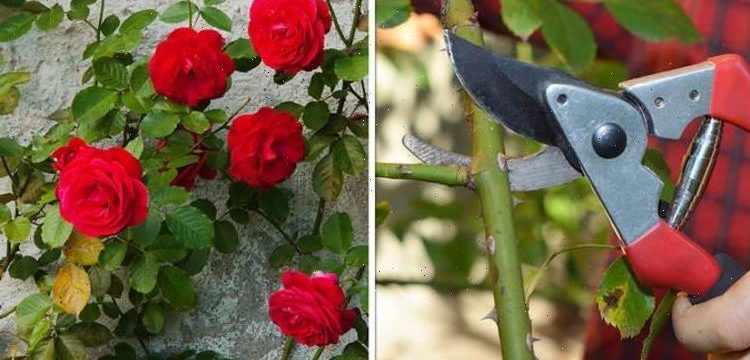Monty Don shares tips for pruning roses
We use your sign-up to provide content in ways you’ve consented to and to improve our understanding of you. This may include adverts from us and 3rd parties based on our understanding. You can unsubscribe at any time. More info
Winter is a slow time for gardening but for climbing roses, it is a crucial season. While growth is slow and few plants are in bloom, the cold weather offers the perfect opportunity to prepare sprawling vines ahead of Spring. Pruning climbers is an easy task to do – and this is how.
When to prune climbing roses
Climbers should be pruned in winter after the flowers have faded and before the dormant season ends.
The prime period to tend to climbing roses is between December and February, making January the ideal month to tackle this task.
According to the Royal Horticultural Society (RHS), there is a “better response from the rose” when pruning is done during the plant’s dormant window.
A mature climbing rose can change the look of your entire garden landscape, so it is crucial to prune correctly in order to maintain strong sprawling vines.


How to prune climbing roses
Support is the key to growing a widely spread, flowering climber – and pruning is the best way to keep a strong structure.
The RHS says: “Climbing roses are not self-clinging and need support of trellis or horizontal wires to which the shoots can be tied”.
Pruning this stunning plant should start with the removal of dead and diseased branches and finish with some essential tying of growing vines.
While pruning is done to encourage new growth, the method by which it is done should vary for younger and older climbers.

How to prune young climbing roses
The RHS’ guide to training and pruning young climbing roses is as follows:
Start by setting the lowest wire 45cm off the ground and space subsequent wires 30cm apart.
Twist shoots around the uprights of pillars, arches or pergolas to encourage flowering shoots to form low down.
Prune slow growing branches from the tip, back to the first strong buds to encourage side shoots.
Remove dead, damaged and diseased growth as well as spindly branches.
DON’T MISS:
How to keep your garden healthy in winter whilst preparing for spring [LATEST]
The four unusual uses for flour around the home – from polish to pests [INSIGHT]
Orchids: Alan Titchmarsh shares ‘trick’ to looking after houseplant [EXPLAINER]
A guide to pruning established climbers
Approach established climbing roses with sharp secateurs to begin pruning dying branches.
Remove limp, dead and diseased growth before washing your tools and working on the rest of the vines without spreading disease.
The RHS recommends tying new shoots to fill supports and finishing by pruning flowered side shoots back by two-thirds of their length.
For a heavily congested structure, get rid of older branches from the base to make space for new growth.

How to prune overgrown climbing roses
Leaving climbing roses untouched throughout winter can quickly lead to an overgrown, jumbled mess.
Not only does this look untidy, but it can also cause climbers to stop growing and leave them unable to produce vibrant blooms during the summer.
To renovate overgrown climbers, follow the RHS’ step-by-step guide:
- Remove dead, dying and weak shoots as well as diseased growth
- Cut old woody branches back to the ground, retaining a maximum of six young, vigorous stems that can be secured to supports
- Saw away dead stumps at the base of the plant to avoid rot caused by gathered rainwater
- Shorten side shoots on the remaining branches and prune tips back by one third to one half
The RHS says: “Give pruned plants a boost in the following spring by spreading a granular rose fertiliser over the soil and mulch them with a 5cm layer of garden compost or well-rotted manure.”
Source: Read Full Article
